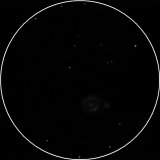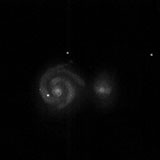
| MESSIER 51 |
|---|
RA: |
13h 29m 54s |
|
DEC: |
+47° 12' 00'' |
|
Type: |
Spiral galaxy |
|
NGC: |
5194 |
|
Magnitude: |
8.40 |
|
Surface brightness : |
12.90 |
|
Apparent dimensions : |
11'x7' |
|
Distance: |
23,000,000 ly |
|
The Whirlpool Galaxy (also known as Messier 51a, M51a, or NGC 5194) is an interacting grand-design spiral galaxy located at a distance of approximately 23 million light-years in the constellation Canes Venatici. It is one of the most famous spiral galaxies in the sky. The galaxy and its companion (NGC 5195) are easily observed by amateur astronomers, and the two galaxies may even be seen with binoculars. The Whirlpool Galaxy is also a popular target for professional astronomers, who study it to further understand galaxy structure (particularly structure associated with the spiral arms) and galaxy interactions. The Whirlpool Galaxy was discovered by Charles Messier on October 13, 1773. Its companion galaxy, NGC 5195, was discovered in 1781 by Pierre Méchain. It was not until 1845 that the Whirlpool Galaxy became the first to be recognized as a spiral. This was achieved by Lord Rosse using a 72 inch reflecting telescope he had constructed at Birr Castle, Ireland. Sometimes M51 is used to refer to the pair of galaxies, in which case the individual galaxies may be referred to as M51A (NGC 5194) and M51B (NGC 5195). In 2005 a supernova (SN 2005cs) was observed in the Whirlpool Galaxy, peaking at apparent magnitude 14. With the recent SN 2005cs derived estimate of 23 Mly distance, and an angular diameter of roughly 11′.2, we can infer that M51's bright circular disk has a radius of about ~38,000 light-years. Its mass is estimated to be 160 billion solar masses. Compared to 100 kly diameter of the Milky Way, M51 has about half its size and mass. Located within the constellation Canes Venatici, M51 is easy to find by following the easternmost star of the Big Dipper, Eta Ursae Majoris, and going 3.5° southeast. Its declination is +47°, so it is circumpolar for observers located above 43°N latitude and reaches high altitudes throughout the northern hemisphere making it an accessible object, especially from the very early hours in winter through the end of spring season, after which summer solstice somewhat hinders observations. M51 is visible through binoculars on a dark night, but with modern amateur telescopes this galaxy is truly a sight to behold. It is very forgiving on the instrument, when seen even through a humble 10 cm telescope the basic outlines of M51 and its companion are visible. Under dark skies and seen with a moderate eyepiece through a 15 cm telescope one can detect M51's intrinsic spiral structure. With larger (>30 cm) instruments M51 is simply breathtaking. The various spiral bands are very obvious and several HII regions appear to be visible, and M51 can be seen to be attached to M51B. As is usual for galaxies, the true extent of its size can only be gathered from inspecting deep photographs, and very long exposures reveal a pretty large nebula extending beyond the visible circular appearance. |
||
Other sketches |
|||||
 |
 |
||||
M51, April 2006. |
M51, January 2007. |
||||
VEDRAN VRHOVAC© 2006.-2007. |
